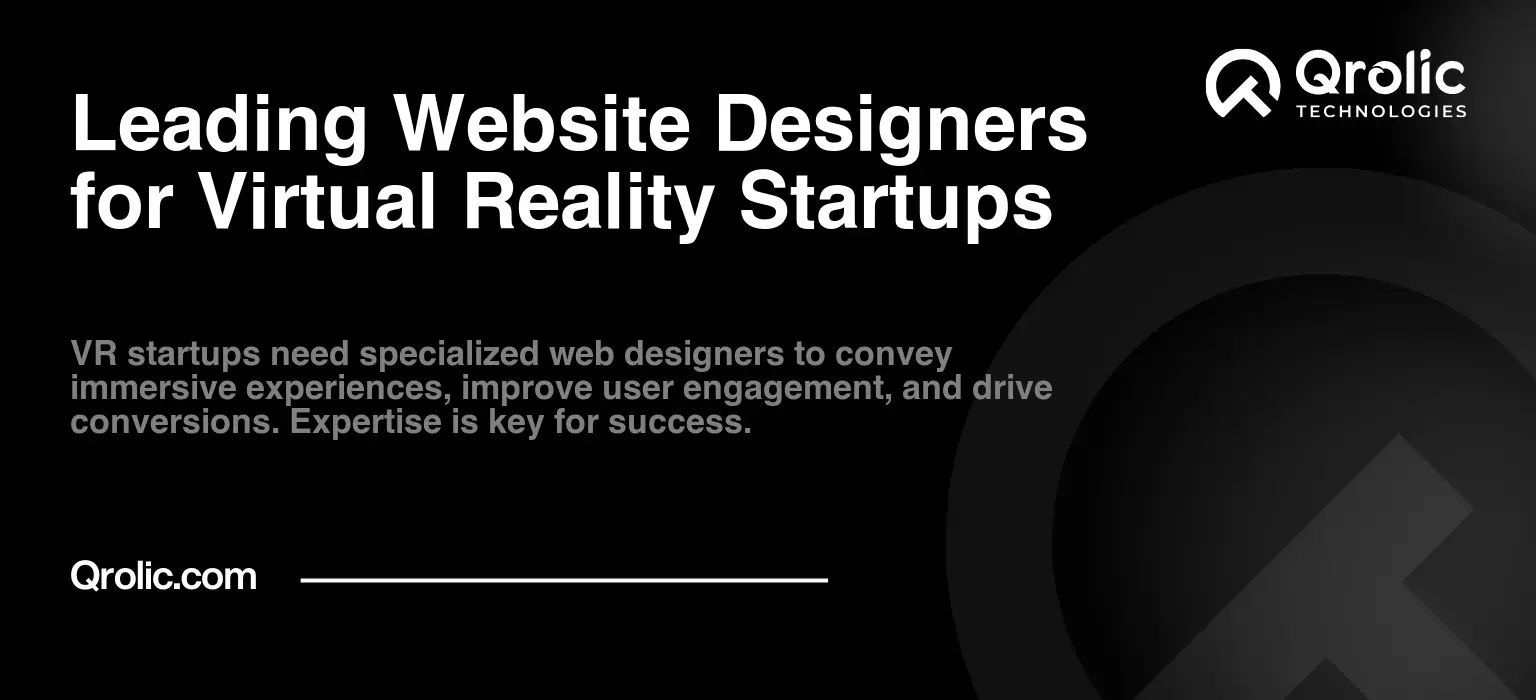Quick Summary:
- Your VR website is your essential online storefront.
- Plan your website by defining audience and goals.
- Use stunning visuals, engaging content, and easy navigation.
- Optimize your site for search and track its performance.
Table of Contents
- Understanding the Foundation: Why Your VR Company Needs a Stellar Website
- Why a Generic Website Won’t Cut It
- The Core Benefits of a Well-Designed VR Company Website
- Defining Your VR Company Website Strategy: Before You Design
- 1. Identify Your Target Audience: Who Are You Trying to Reach?
- 2. Define Your Website Goals: What Do You Want to Achieve?
- 3. Craft Your Unique Value Proposition (UVP): Why Choose You?
- 4. Competitor Analysis: Learn from the Best (and the Worst)
- 5. Keyword Research: Optimize for Search Engines
- Designing an Immersive Experience: Key Elements of Your VR Company Website
- 1. Visual Appeal: Stunning Graphics and Videos
- 2. User-Friendly Navigation: Make It Easy to Explore
- 3. Compelling Content: Tell Your Story and Showcase Your Expertise
- 4. Immersive Elements: Bring VR to the Web
- 5. Speed and Performance: Don’t Make Visitors Wait
- Essential Pages for Your VR Company Website: Building a Comprehensive Resource
- 1. Homepage: Make a Strong First Impression
- 2. About Us: Tell Your Story
- 3. Services/Solutions: Showcase Your Offerings
- 4. Portfolio/Case Studies: Prove Your Expertise
- 5. Blog: Share Your Knowledge and Expertise
- 6. Contact Us: Make It Easy to Connect
- Optimizing for Search Engines (SEO): Get Found Online
- 1. On-Page SEO: Optimize Your Website Content
- 2. Off-Page SEO: Build Authority and Backlinks
- 3. Technical SEO: Ensure Your Website is Crawlable
- Measuring Success and Iterating: Continuous Improvement
- 1. Track Key Metrics: Use Analytics Tools
- 2. Analyze User Behavior: Understand How People Interact with Your Website
- 3. Gather Feedback: Ask Your Users for Their Opinions
- 4. Iterate and Improve: Continuously Refine Your Website
- Qrolic Technologies: Your Partner in VR Website Development
- How Qrolic Technologies Can Help:
- Conclusion: Your VR Company Website – An Essential Investment
Understanding the Foundation: Why Your VR Company Needs a Stellar Website
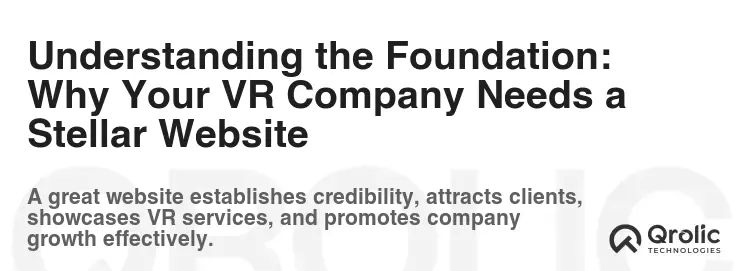
In today’s digital landscape, a website is more than just an online brochure; it’s the virtual storefront, the 24/7 sales representative, and the cornerstone of your brand’s online presence. This is especially true for companies operating in cutting-edge fields like virtual reality (VR). A compelling website is absolutely essential for a VR company. It showcases your innovation, builds trust, and ultimately drives business.
Why a Generic Website Won’t Cut It
The VR industry is visually driven, immersive, and innovative. A generic, cookie-cutter website simply won’t capture the essence of your brand or resonate with your target audience. It needs to be more than just informative; it needs to be experiential.
The Core Benefits of a Well-Designed VR Company Website
- Brand Authority & Credibility: A professional, well-designed website instantly establishes your company as a legitimate and trustworthy player in the VR space. It shows potential clients and investors that you are serious about your business.
- Showcase Your Expertise & Innovation: Your website is the perfect platform to showcase your VR projects, technologies, and expertise. Use high-quality visuals and engaging content to demonstrate your capabilities.
- Attract & Convert Leads: A user-friendly website, optimized for search engines, can attract qualified leads interested in your VR solutions. Convert those leads into paying customers with clear calls-to-action and compelling offers.
- Educate Your Audience: VR is still a relatively new technology. Your website can serve as an educational resource, explaining the benefits of VR and how your company’s solutions can help businesses.
- Recruit Top Talent: A compelling website can attract talented VR developers, designers, and engineers who are passionate about the field.
- Control Your Narrative: In a competitive market, it’s crucial to control your brand narrative. Your website allows you to tell your story, highlight your unique value proposition, and differentiate yourself from the competition.
- Improve Customer Service: Provide FAQs, tutorials, and contact information on your website to improve customer service and build stronger relationships with your clients.
Defining Your VR Company Website Strategy: Before You Design
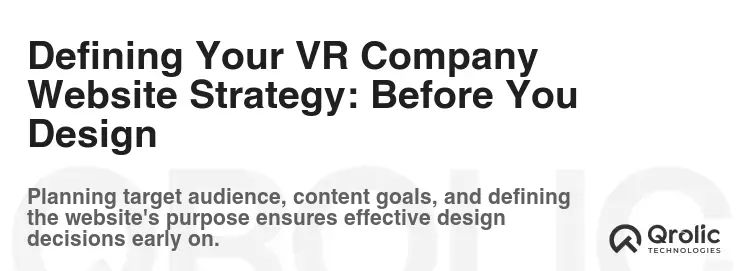
Before you even think about colors, fonts, or layouts, you need a solid strategy. This will be the foundation of your VR company design and ensure your website achieves its intended goals.
1. Identify Your Target Audience: Who Are You Trying to Reach?
Understanding your target audience is paramount. Are you targeting businesses looking for VR training solutions? Gamers interested in immersive experiences? Healthcare professionals seeking VR therapy applications? Define your audience profiles and tailor your website content and design to their specific needs and interests. Consider factors like:
- Industry: Which industries are you targeting (e.g., education, healthcare, manufacturing, entertainment)?
- Job Title: What roles are you trying to reach (e.g., training managers, CEOs, gamers, therapists)?
- Technical Proficiency: How familiar is your audience with VR technology?
- Pain Points: What problems are they trying to solve with VR?
- Goals: What are they hoping to achieve with VR?
2. Define Your Website Goals: What Do You Want to Achieve?
What do you want your website to accomplish? Are you primarily focused on lead generation, brand awareness, sales, or recruitment? Define specific, measurable, achievable, relevant, and time-bound (SMART) goals for your website. Examples include:
- Increase Website Traffic by 20% in the next quarter.
- Generate 50 qualified leads per month.
- Increase online demo requests by 15%.
- Improve brand awareness by 10% as measured by social media engagement.
3. Craft Your Unique Value Proposition (UVP): Why Choose You?
In a crowded marketplace, you need a clear and compelling UVP that differentiates you from the competition. What makes your VR company unique? What problems do you solve better than anyone else? Your UVP should be prominently displayed on your homepage and throughout your website. Consider these aspects:
- Focus on the benefits, not just the features.
- Be specific and avoid generic statements.
- Address your target audience’s pain points.
- Highlight your competitive advantages.
4. Competitor Analysis: Learn from the Best (and the Worst)
Analyze your competitors’ websites to identify what they’re doing well and where they’re falling short. This will help you identify opportunities to differentiate your website and offer a superior user experience. Look at:
- Design: What design elements are effective? What feels outdated?
- Content: What information do they provide? Is it engaging and informative?
- Functionality: How easy is it to navigate their website? Do they offer interactive elements?
- SEO: What keywords are they targeting? How well are they ranking in search results?
- User Experience (UX): How intuitive and enjoyable is it to use their website?
5. Keyword Research: Optimize for Search Engines
Conduct thorough keyword research to identify the terms your target audience is using to search for VR solutions. This will inform your website content and SEO strategy. Tools like Google Keyword Planner, SEMrush, and Ahrefs can help you identify relevant keywords. Focus on keywords such as “virtual reality website”, “VR company design”, “VR solutions”, “immersive experiences”, and industry-specific terms related to your target audience.
Designing an Immersive Experience: Key Elements of Your VR Company Website
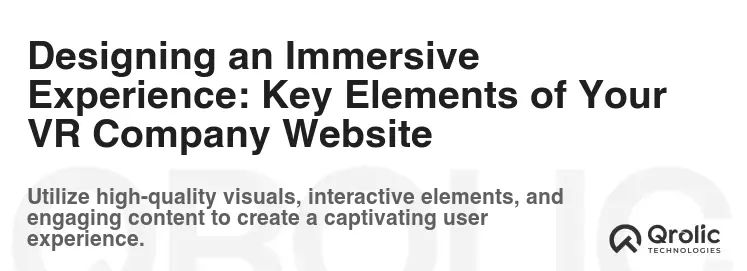
Now that you have a solid strategy in place, it’s time to focus on the design and functionality of your website. The goal is to create an immersive experience that captures the essence of VR and engages your visitors.
1. Visual Appeal: Stunning Graphics and Videos
VR is a visually driven medium, so your website needs to be visually stunning. Use high-quality graphics, videos, and animations to showcase your VR projects and technologies.
- High-Resolution Images: Use crisp, high-resolution images that showcase the visual fidelity of your VR experiences.
- Engaging Videos: Create compelling videos that demonstrate the power and potential of your VR solutions. Include behind-the-scenes footage, client testimonials, and product demos.
- 360° Views and Interactive Elements: Consider incorporating 360° views or interactive elements to give visitors a taste of the immersive nature of VR.
- Consistent Branding: Maintain a consistent visual style throughout your website, using your brand colors, fonts, and logo.
2. User-Friendly Navigation: Make It Easy to Explore
Your website should be easy to navigate, with a clear and intuitive structure. Visitors should be able to find the information they need quickly and easily.
- Clear Menu Structure: Use a clear and concise menu structure that makes it easy for visitors to navigate your website.
- Search Functionality: Implement a robust search function that allows visitors to quickly find specific information.
- Breadcrumb Navigation: Use breadcrumb navigation to help visitors understand their location on your website.
- Mobile-Friendly Design: Ensure your website is fully responsive and optimized for mobile devices.
3. Compelling Content: Tell Your Story and Showcase Your Expertise
Your website content should be informative, engaging, and tailored to your target audience. Use storytelling to connect with your visitors on an emotional level and showcase your expertise.
- Clear and Concise Language: Use clear and concise language that is easy to understand. Avoid jargon and technical terms that your audience may not be familiar with.
- Compelling Case Studies: Showcase your successful VR projects with detailed case studies that highlight the benefits and results you have achieved for your clients.
- Thought Leadership Content: Publish blog posts, articles, and white papers that demonstrate your expertise and thought leadership in the VR industry.
- Client Testimonials: Include client testimonials to build trust and credibility.
- Strong Calls-to-Action: Use strong calls-to-action to encourage visitors to take the next step, such as requesting a demo, contacting your sales team, or subscribing to your newsletter.
4. Immersive Elements: Bring VR to the Web
While users aren’t in VR, you can incorporate elements that give a taste of the immersive experience.
- Parallax Scrolling: Create depth and visual interest with parallax scrolling effects.
- Interactive Animations: Use subtle animations to draw attention to key elements and make your website more engaging.
- Virtual Tours: Offer virtual tours of your VR development studio or showcase your VR applications in a virtual environment.
- VR-Ready Content: If possible, offer VR-ready content that visitors can view with a VR headset.
5. Speed and Performance: Don’t Make Visitors Wait
Website Speed is crucial for user experience and SEO. Optimize your website for speed and performance to ensure a seamless browsing experience.
- Optimize Images and Videos: Compress images and videos to reduce file sizes without sacrificing quality.
- Use a Content Delivery Network (CDN): Use a CDN to distribute your website content across multiple servers, improving loading times for visitors around the world.
- Minimize HTTP Requests: Reduce the number of HTTP requests by combining CSS and JavaScript files.
- Choose a Fast Hosting Provider: Choose a reliable hosting provider that offers fast server response times.
Essential Pages for Your VR Company Website: Building a Comprehensive Resource
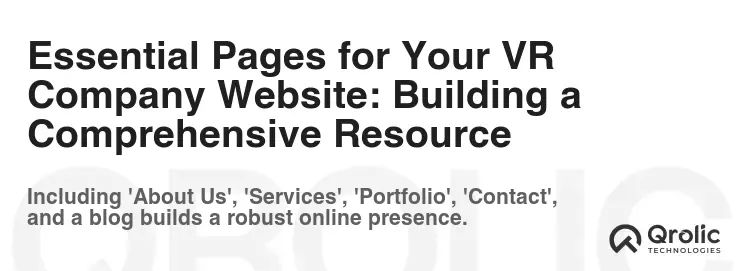
Your website should include several essential pages that provide visitors with the information they need to learn about your company, your services, and your VR solutions.
1. Homepage: Make a Strong First Impression
Your homepage is the first impression your company makes online, so it needs to be compelling and informative.
- Clearly state your UVP: What makes you different?
- Showcase your best VR projects: Use high-quality visuals.
- Include a strong call-to-action: Encourage visitors to take the next step.
- Provide a brief overview of your services: What solutions do you offer?
- Make it visually appealing and easy to navigate.
2. About Us: Tell Your Story
The About Us page is your opportunity to tell your company’s story, build trust, and connect with your visitors on a personal level.
- Share your company’s mission and values: What do you stand for?
- Highlight your team’s expertise and experience: Why are you qualified to solve your clients’ problems?
- Showcase your company culture: What is it like to work with you?
- Include photos of your team and office: Make it personal.
3. Services/Solutions: Showcase Your Offerings
This page should detail the specific VR services or solutions you offer.
- Clearly define each service or solution.
- Explain the benefits and features of each offering.
- Use visuals to illustrate your solutions in action.
- Provide pricing information (if applicable).
- Include case studies or testimonials related to each service.
4. Portfolio/Case Studies: Prove Your Expertise
Show, don’t just tell. Your portfolio or case studies page is where you showcase your best VR projects and demonstrate your expertise.
- Include detailed descriptions of each project.
- Highlight the challenges you faced and the solutions you implemented.
- Showcase the results you achieved for your clients.
- Use high-quality visuals to showcase your work.
- Include client testimonials to build credibility.
5. Blog: Share Your Knowledge and Expertise
A blog is a valuable tool for sharing your knowledge, attracting organic traffic, and establishing your company as a thought leader in the VR industry.
- Write about topics that are relevant to your target audience.
- Share insights and tips on VR development, design, and implementation.
- Publish case studies and success stories.
- Offer your perspective on industry trends and news.
- Optimize your blog posts for search engines.
6. Contact Us: Make It Easy to Connect
Your Contact Us page should make it easy for visitors to connect with your company.
- Include a contact form.
- Provide your email address and phone number.
- Include your physical address (if applicable).
- Embed a map showing your location.
- Link to your social media profiles.
Optimizing for Search Engines (SEO): Get Found Online
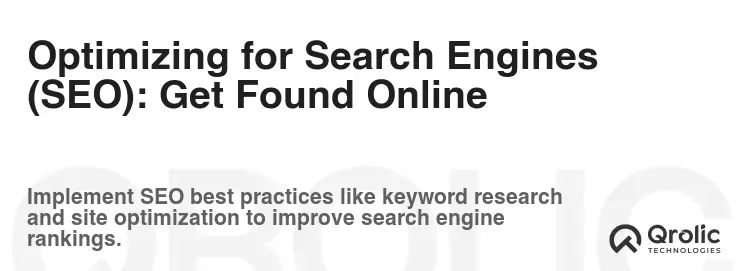
A beautiful website is useless if no one can find it. Optimizing your website for search engines (SEO) is essential for driving organic traffic and attracting qualified leads.
1. On-Page SEO: Optimize Your Website Content
On-page SEO involves optimizing your website content to improve its ranking in search results.
- Keyword Optimization: Use relevant keywords throughout your website content, including your page titles, headings, descriptions, and body text. Focus on keywords like “virtual reality website”, “VR company design”, and related industry terms.
- Meta Descriptions: Write compelling meta descriptions for each page to encourage users to click on your website in search results.
- Image Alt Text: Add descriptive alt text to all images to help search engines understand what the images are about.
- Internal Linking: Link to other relevant pages on your website to improve navigation and SEO.
- Mobile-Friendliness: Ensure your website is fully responsive and optimized for mobile devices.
2. Off-Page SEO: Build Authority and Backlinks
Off-page SEO involves building authority and backlinks from other websites.
- Backlink Building: Earn backlinks from reputable websites in the VR industry.
- Social Media Marketing: Promote your website and content on social media to increase visibility and drive traffic.
- Online Directory Listings: List your company in online directories relevant to the VR industry.
- Guest Blogging: Write guest blog posts for other websites in the VR industry to build backlinks and reach a wider audience.
3. Technical SEO: Ensure Your Website is Crawlable
Technical SEO involves optimizing your website’s technical aspects to ensure it is easily crawlable and indexable by search engines.
- Sitemap Submission: Submit your website’s sitemap to Google Search Console to help search engines discover and crawl your website.
- Robots.txt File: Create a robots.txt file to tell search engines which pages to crawl and which to ignore.
- Website Speed Optimization: Optimize your website for speed and performance to improve user experience and SEO.
- HTTPS Security: Ensure your website is secured with HTTPS.
Measuring Success and Iterating: Continuous Improvement
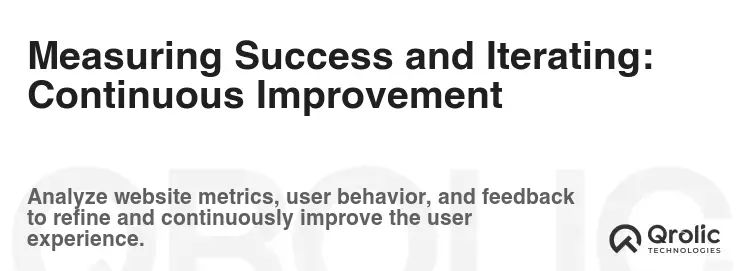
Your website is not a “set it and forget it” project. You need to continuously monitor its performance, identify areas for improvement, and iterate on your design and content.
1. Track Key Metrics: Use Analytics Tools
Use analytics tools like Google Analytics to track key metrics such as website traffic, bounce rate, conversion rate, and time on site.
- Website Traffic: How many people are visiting your website?
- Bounce Rate: How many people are leaving your website after viewing only one page?
- Conversion Rate: How many people are completing your desired actions (e.g., requesting a demo, contacting sales)?
- Time on Site: How long are people spending on your website?
- Top Pages: Which pages are the most popular?
2. Analyze User Behavior: Understand How People Interact with Your Website
Use heatmaps and user recordings to analyze how people interact with your website.
- Heatmaps: Show where users are clicking, scrolling, and spending the most time on your website.
- User Recordings: Record user sessions to see how people navigate your website and identify areas of frustration.
- A/B Testing: Experiment with different versions of your website to see which performs best.
3. Gather Feedback: Ask Your Users for Their Opinions
Ask your users for their feedback on your website.
- Surveys: Conduct online surveys to gather feedback on your website’s design, content, and functionality.
- User Interviews: Conduct user interviews to gain deeper insights into your users’ needs and preferences.
- Usability Testing: Conduct usability testing to identify usability issues and areas for improvement.
4. Iterate and Improve: Continuously Refine Your Website
Based on your data and feedback, continuously iterate on your website’s design, content, and functionality to improve user experience and achieve your business goals.
Qrolic Technologies: Your Partner in VR Website Development
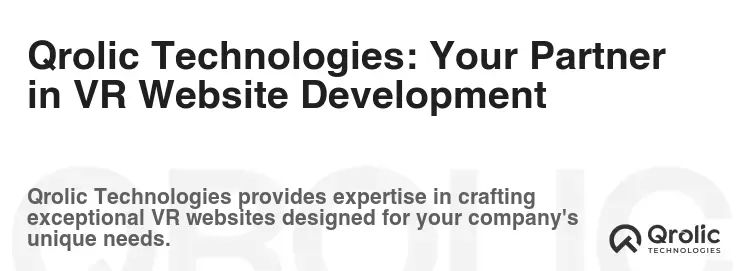
Creating a compelling virtual reality website requires specialized expertise. Qrolic Technologies (https://qrolic.com/) is a leading web development company with a proven track record of designing and developing high-quality websites for VR companies. We understand the unique challenges and opportunities of the VR industry and can help you create a website that showcases your innovation, attracts qualified leads, and drives business growth.
How Qrolic Technologies Can Help:
- Custom VR Website Design: We create custom VR website designs that are visually stunning, user-friendly, and optimized for search engines.
- VR-Ready Content Development: We develop VR-ready content, including 360° videos, interactive animations, and virtual tours, to bring your website to life.
- SEO Optimization: We optimize your website for search engines to ensure it ranks well in search results and attracts qualified leads.
- Ongoing Support and Maintenance: We provide ongoing support and maintenance to ensure your website is always up-to-date and performing at its best.
- E-commerce Solutions for VR: We design e-commerce solutions for VR companies that allows users to engage with your VR world using headsets.
Conclusion: Your VR Company Website – An Essential Investment
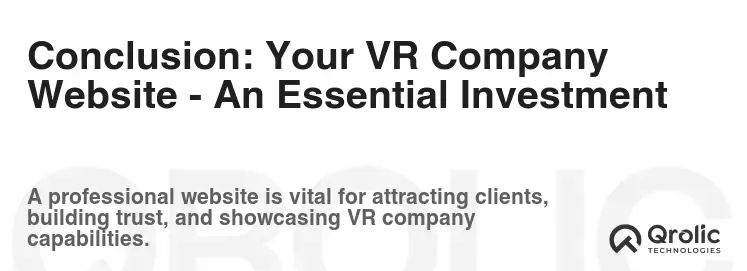
In conclusion, a well-designed and optimized website is an essential guide for any VR company looking to succeed in today’s competitive market. It’s your virtual storefront, your sales representative, and your brand ambassador. By following the steps outlined in this guide, you can create a website that showcases your innovation, attracts qualified leads, and drives business growth. Remember, your VR company design is an investment in your future.


